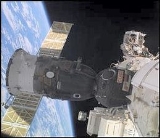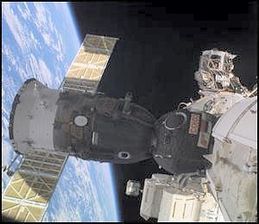
Expedition 7
Encyclopedia
Expedition 7 was the seventh expedition to the International Space Station
.

from the Russian Space Agency's Baikonur Cosmodrome in Kazakhstan on 25 April 2003, at 05:56:20 UTC. The Soyuz docked on 28 April 2003 and took over command of the ISS. The Space Shuttle
fleet had been grounded due to the Columbia disaster, so the crew size was reduced to two, as opposed to the three that could be carried by the shuttle. The Expedition Seven crew—along with European Space Agency
Astronaut Pedro Duque
-- landed back on Earth on 27 October 2003 at Kazakhstan at 02:41:20 UTC, after undocking from the International Space Station in their Soyuz spacecraft at 23:17 UTC.
Due to the reduced crew size, the scientific work had to be scaled down as well. Only 15 different experiments were conducted during the mission. Malenchenko and Lu were also tasked with periodic maintenance work on the station, as well as spacewalk training (although no spacewalks were planned. Supplies were delivered by Progress M1-10
in June and Progress M-48
in August.
From Houston, ISS Spacecraft Communicator Mike Fossum informed Expedition 7 Commander Yuri Malenchenko and Science Officer Edward Lu on 15 October 2003 of the successful launch of the Long March rocket
carrying the Shenzhou 5
spacecraft and Chinese
astronaut
Yáng Lìwěi
. "It's really some exciting news to share. The world's spacefaring nations have been joined by a new member tonight: China."
"First off, we want to congratulate them," Lu replied. "The more people that go into space, the better off we all are. This is a great achievement and good for everyone in the long run." In Chinese, he later added, "Welcome to space. Have a safe journey."
"I would also like to say I love to have somebody else in space instead of me and Ed," said Malenchenko. "I also know this is great for thousands and thousands of people from China. I congratulate all of them."
Malenchenko and Lu were previously crewmates on the STS-106
shuttle mission and did a spacewalk together during that flight.
International Space Station
The International Space Station is a habitable, artificial satellite in low Earth orbit. The ISS follows the Salyut, Almaz, Cosmos, Skylab, and Mir space stations, as the 11th space station launched, not including the Genesis I and II prototypes...
.
Crew
Mission parameters
- PerigeePerigeePerigee is the point at which an object makes its closest approach to the Earth.. Often the term is used in a broader sense to define the point in an orbit where the orbiting body is closest to the body it orbits. The opposite is the apogee, the farthest or highest point.The Greek prefix "peri"...
: 384 km - Apogee: 396 km
- InclinationInclinationInclination in general is the angle between a reference plane and another plane or axis of direction.-Orbits:The inclination is one of the six orbital parameters describing the shape and orientation of a celestial orbit...
: 51.6° - PeriodOrbital periodThe orbital period is the time taken for a given object to make one complete orbit about another object.When mentioned without further qualification in astronomy this refers to the sidereal period of an astronomical object, which is calculated with respect to the stars.There are several kinds of...
: 92 min

Mission objectives
The seventh crew of the International Space Station lifted off in Soyuz TMA-2Soyuz TMA-2
Soyuz TMA-2 was a Soyuz mission to the International Space Station launched by a Soyuz FG launch vehicle...
from the Russian Space Agency's Baikonur Cosmodrome in Kazakhstan on 25 April 2003, at 05:56:20 UTC. The Soyuz docked on 28 April 2003 and took over command of the ISS. The Space Shuttle
Space Shuttle
The Space Shuttle was a manned orbital rocket and spacecraft system operated by NASA on 135 missions from 1981 to 2011. The system combined rocket launch, orbital spacecraft, and re-entry spaceplane with modular add-ons...
fleet had been grounded due to the Columbia disaster, so the crew size was reduced to two, as opposed to the three that could be carried by the shuttle. The Expedition Seven crew—along with European Space Agency
European Space Agency
The European Space Agency , established in 1975, is an intergovernmental organisation dedicated to the exploration of space, currently with 18 member states...
Astronaut Pedro Duque
Pedro Duque
Pedro Duque Duque is a Spanish astronaut and a veteran of two space missions.Duque earned a degree in Aeronautical Engineering from the Universidad Politécnica de Madrid in 1986. He worked for GMV and for the European Space Agency for six years before being selected as an astronaut candidate in...
-- landed back on Earth on 27 October 2003 at Kazakhstan at 02:41:20 UTC, after undocking from the International Space Station in their Soyuz spacecraft at 23:17 UTC.
Due to the reduced crew size, the scientific work had to be scaled down as well. Only 15 different experiments were conducted during the mission. Malenchenko and Lu were also tasked with periodic maintenance work on the station, as well as spacewalk training (although no spacewalks were planned. Supplies were delivered by Progress M1-10
Progress M1-10
Progress M1-10, identified by NASA as Progress 11 or 11P, was a Progress spacecraft used to resupply the International Space Station. It was a Progress-M1 11F615A55 spacecraft, with the serial number 259....
in June and Progress M-48
Progress M-48
Progress M-48, identified by NASA as Progress 12 or 12P, was a Progress spacecraft used to resupply the International Space Station. It was a Progress-M 11F615A55 spacecraft, with the serial number 248....
in August.
From Houston, ISS Spacecraft Communicator Mike Fossum informed Expedition 7 Commander Yuri Malenchenko and Science Officer Edward Lu on 15 October 2003 of the successful launch of the Long March rocket
Long March rocket
A Long March rocket or Chang Zheng rocket as in Chinese pinyin is any rocket in a family of expendable launch systems operated by the People's Republic of China. Development and design falls under the auspices of the China Academy of Launch Vehicle Technology...
carrying the Shenzhou 5
Shenzhou 5
Shenzhou 5 — was the first human spaceflight mission of the People's Republic of China , launched on October 15, 2003. The Shenzhou spacecraft was launched on a Long March 2F launch vehicle. There had been four previous flights of unmanned Shenzhou missions since 1999...
spacecraft and Chinese
China
Chinese civilization may refer to:* China for more general discussion of the country.* Chinese culture* Greater China, the transnational community of ethnic Chinese.* History of China* Sinosphere, the area historically affected by Chinese culture...
astronaut
Astronaut
An astronaut or cosmonaut is a person trained by a human spaceflight program to command, pilot, or serve as a crew member of a spacecraft....
Yáng Lìwěi
Yang Liwei
Yáng Lìwěi is a Chinese major general and military pilot and a CNSA astronaut. He was the first man sent into space by the Chinese space program and his mission, Shenzhou 5, made China the third country to independently send people into space.-Background:...
. "It's really some exciting news to share. The world's spacefaring nations have been joined by a new member tonight: China."
"First off, we want to congratulate them," Lu replied. "The more people that go into space, the better off we all are. This is a great achievement and good for everyone in the long run." In Chinese, he later added, "Welcome to space. Have a safe journey."
"I would also like to say I love to have somebody else in space instead of me and Ed," said Malenchenko. "I also know this is great for thousands and thousands of people from China. I congratulate all of them."
Malenchenko and Lu were previously crewmates on the STS-106
STS-106
STS-106 was a Space Shuttle mission to the International Space Station flown by Space Shuttle Atlantis.-Crew:-Mission parameters:*Mass:**Orbiter Liftoff: **Orbiter Landing: **Payload: *Perigee: 233 mi...
shuttle mission and did a spacewalk together during that flight.
External links
- ISS Expedition 7 Crew site from Nasa.
- Expedition 7 Photography

